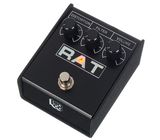Unlike overdrives which used soft-clipping diodes, like the Tube Screamer, the Rat employed two symmetrical diodes to ground after the gain stage, resulting in a hard, square-wave clip. However, that’s not the end of the RAT’s tone story; it’s actually a little weirder than that.
The Rat has found a home on countless guitarists’ pedalboards, from shredders like Nuno Bettencourt to a who’s-who of grunge and shoegaze. Most notably, Rivers Cuomo from Weezer is a fan, and all the members of Nirvana are known to have used a RAT - although admittedly, Dave Grohl with his later band Foo Fighters - while shoegazers like Neil Halstead of Slowdive and Mark Gardener of Ride are also owners.
Distortion:
The distortion pot controls voltage gain, and thus the amount of clipping. On paper, it can deliver a whopping 67dB of gain, but in practice due to the slew characteristics of the LM308 op-amp, this number will not be reached. Despite the RAT shining at higher gain settings, it’s also a surprisingly solid low-gain drive, particularly for boosting dirty amps, and has a fantastic mid-bump.
Filter:
The filter, or tone control, is a simple low-pass filter. With the bass pulled back, the signal will be closer to a square-wave, while with it fully open, the response will look almost triangle-wave shaped. Obviously, the EQ settings on your amp will also have a significant effect on the overall timbre and EQ profile of the distortion.
Volume:
Unlike some other pedals, changing the output volume will not alter the tone, thanks to a JFET buffer between the two circuit blocks. The output block is a simple 100K pot blending signal to ground.

